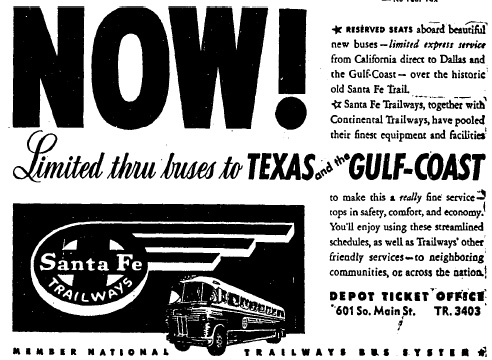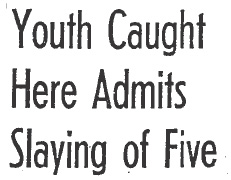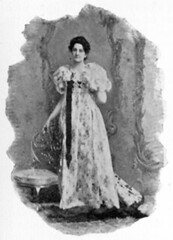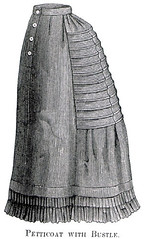 What would you do if you were waiting at a downtown bus depot and a woman suddenly started shouting that she’d been stabbed? Would you rush to her aid, or would you assume that she’s just another SRO Land eccentric and ignore her? On September 28, 1948 thirty-nine year old Miss Essie Lee Mitchell of Oceanside was waiting in the lounge of the Santa Fe Trailways bus depot at 601 S. Main Street. She was unaware that she’d been followed, so she was shocked when a young man walked up to her, thrust a knife into her ribs, and demanded money. Because it was a crowded terminal, and presumably help was at hand, Essie began to scream hysterically. Rather than immediately taking flight Essie’s attacker stabbed her, and then he took off.
What would you do if you were waiting at a downtown bus depot and a woman suddenly started shouting that she’d been stabbed? Would you rush to her aid, or would you assume that she’s just another SRO Land eccentric and ignore her? On September 28, 1948 thirty-nine year old Miss Essie Lee Mitchell of Oceanside was waiting in the lounge of the Santa Fe Trailways bus depot at 601 S. Main Street. She was unaware that she’d been followed, so she was shocked when a young man walked up to her, thrust a knife into her ribs, and demanded money. Because it was a crowded terminal, and presumably help was at hand, Essie began to scream hysterically. Rather than immediately taking flight Essie’s attacker stabbed her, and then he took off.  Essie rushed out of the lounge shrieking “stop the man”, but her entreaties were completely ignored by onlookers. The injured woman couldn’t believe it. What the heck was the matter with everyone – didn’t they hear her? Why didn’t anyone step up to assist her? Maybe a visual aid would get someone’s attention. Essie pulled open her coat and shouted “Honestly, I am stabbed – look at the blood”. Help was forthcoming at last; cops apprehended eighteen year old Raul Portillo and booked him on a charge of attempted murder.
Essie rushed out of the lounge shrieking “stop the man”, but her entreaties were completely ignored by onlookers. The injured woman couldn’t believe it. What the heck was the matter with everyone – didn’t they hear her? Why didn’t anyone step up to assist her? Maybe a visual aid would get someone’s attention. Essie pulled open her coat and shouted “Honestly, I am stabbed – look at the blood”. Help was forthcoming at last; cops apprehended eighteen year old Raul Portillo and booked him on a charge of attempted murder.
Category: Joan
Hide In Plain Sight
 If you were an eighteen year old boy from a small Northern California town and you’d just murdered five family members with a .38, what would your next move be? Raymond Latshaw found himself in that situation and he decided to run to a big city where it would be easier to live undetected. After abandoning his now deceased family in rural Auburn, he headed to the nearest city – Sacramento. Maybe he felt too close to home to be comfortable, but in any case he soon fled to San Francisco where he stayed at the York Hotel on Nob Hill. The York hotel would be featured in Alfred Hitchcock’s 1958 Film “Vertigo”. (In fact the hotel has been renamed the Hotel Vertigo!) I wonder if Hitchcock knew that a young multiple murderer had once lodged there.
If you were an eighteen year old boy from a small Northern California town and you’d just murdered five family members with a .38, what would your next move be? Raymond Latshaw found himself in that situation and he decided to run to a big city where it would be easier to live undetected. After abandoning his now deceased family in rural Auburn, he headed to the nearest city – Sacramento. Maybe he felt too close to home to be comfortable, but in any case he soon fled to San Francisco where he stayed at the York Hotel on Nob Hill. The York hotel would be featured in Alfred Hitchcock’s 1958 Film “Vertigo”. (In fact the hotel has been renamed the Hotel Vertigo!) I wonder if Hitchcock knew that a young multiple murderer had once lodged there.  York Hotel Interior With the cops closing in on him, Raymond left San Francisco and boarded a plane for Los Angeles. He booked a room at the Biltmore Hotel and stayed for a couple of weeks, then left without paying his bill. In wartime Los Angeles, Raymond would have found it very easy to disappear because the city was jammed with military personnel and civilian war workers. In fact, if it hadn’t been for eagle-eyed traffic patrolman and 20 year LAPD veteran Clarence Clarke, Raymond may have continued to fly under the radar, just like a German Messerschmitt. But this was not to be. Officer Clarke was directing traffic on Broadway near 7th in front of one of the movie palaces (not identified by name in the LA Times coverage), when he noticed that the doorman bore a striking resemblance to a young man he’d seen on a wanted bulletin.
York Hotel Interior With the cops closing in on him, Raymond left San Francisco and boarded a plane for Los Angeles. He booked a room at the Biltmore Hotel and stayed for a couple of weeks, then left without paying his bill. In wartime Los Angeles, Raymond would have found it very easy to disappear because the city was jammed with military personnel and civilian war workers. In fact, if it hadn’t been for eagle-eyed traffic patrolman and 20 year LAPD veteran Clarence Clarke, Raymond may have continued to fly under the radar, just like a German Messerschmitt. But this was not to be. Officer Clarke was directing traffic on Broadway near 7th in front of one of the movie palaces (not identified by name in the LA Times coverage), when he noticed that the doorman bore a striking resemblance to a young man he’d seen on a wanted bulletin.  Raymond Latshaw Acting on his hunch, Clarke approached the teenaged doorman. When Latshaw saw the cop coming towards him, he knew that he was busted – he didn’t even try to make a break for it. Identifying himself as the wanted man, he quickly confessed to the slayings. According to the shy and awkward killer, he’d snapped when he heard his father and stepmother arguing. He told LA Times reporters: “I was tending my rabbits when they quarreled. I went and got my father’s gun from the house, and shot him in the head.” Why, after shooting his father to protect his stepmother, did Raymond kill the other four members of his family, including his six year old half brother Charles? Raymond said that they were all witnesses, and he shot them to keep them quiet. Latshaw would ultimately plead guilty in a Northern California courtroom. He was sentenced to life imprisonment in San Quentin.
Raymond Latshaw Acting on his hunch, Clarke approached the teenaged doorman. When Latshaw saw the cop coming towards him, he knew that he was busted – he didn’t even try to make a break for it. Identifying himself as the wanted man, he quickly confessed to the slayings. According to the shy and awkward killer, he’d snapped when he heard his father and stepmother arguing. He told LA Times reporters: “I was tending my rabbits when they quarreled. I went and got my father’s gun from the house, and shot him in the head.” Why, after shooting his father to protect his stepmother, did Raymond kill the other four members of his family, including his six year old half brother Charles? Raymond said that they were all witnesses, and he shot them to keep them quiet. Latshaw would ultimately plead guilty in a Northern California courtroom. He was sentenced to life imprisonment in San Quentin.
Fit? Or be tied?
 Whether or not to use cosmetics would be a social and feminist issue in the 1910s and 1920s; however, in the late 1800s the hot button issue for women was dress reform. Many women were tired of being laced into corsets so tight that their health was permanently impaired. Corseting could result in damaged or broken ribs and difficulty in breathing (often the shortness of breath was mistaken for the symptoms of tuberculosis). And the romantic fainting and swooning spells which required households to have smelling salts on hand were not so romantic when you consider that they were the result of restricted lung capacity. There is also compelling evidence that some women used corsets as a way to terminate an unwanted pregnancy!
Whether or not to use cosmetics would be a social and feminist issue in the 1910s and 1920s; however, in the late 1800s the hot button issue for women was dress reform. Many women were tired of being laced into corsets so tight that their health was permanently impaired. Corseting could result in damaged or broken ribs and difficulty in breathing (often the shortness of breath was mistaken for the symptoms of tuberculosis). And the romantic fainting and swooning spells which required households to have smelling salts on hand were not so romantic when you consider that they were the result of restricted lung capacity. There is also compelling evidence that some women used corsets as a way to terminate an unwanted pregnancy!  Internal organs rearranged. Sometimes a tight laced corset was a requisite for employment. Women who were employed in dress shops, and therefore required to model the latest fashions, were often subjected to the most painful restraint. The following quote appeared in the Chicago Tribune on November 3, 1907: “The girls are laced up till they are nearly cut in two. Locked corsets are used, the key being kept by the manageress, and the corsets being worn night and day.”
Internal organs rearranged. Sometimes a tight laced corset was a requisite for employment. Women who were employed in dress shops, and therefore required to model the latest fashions, were often subjected to the most painful restraint. The following quote appeared in the Chicago Tribune on November 3, 1907: “The girls are laced up till they are nearly cut in two. Locked corsets are used, the key being kept by the manageress, and the corsets being worn night and day.”  Mrs. Alice Jenness Miller Photo – Univ of Pennsylvania One of the proponents of dress reform for health and aesthetic reasons was Mrs. Alice Jenness Miller. On April 5, 1889 Mrs. Miller appeared at the Los Angeles Theater to give a demonstration of her comfortable dresses and undergarments to the women of the city. According to newspaper accounts it was standing room only in the theater when Mrs. M. took the stage. Men were shooed out of the place so that the reformer could model her undergarments without embarrassment. Miller addressed the crowd and told them that the trunk of clothing that she used for her demonstrations had gone missing, and she made a snarky comment about the incompetence of the men in charge of the trunk. Her remark made the women in the audience chuckle knowingly and when the laughter had subsided Miller launched into her lecture. The women in the audience need not have been worried that Miller’s presentation would suffer as a result of the missing trunk – she was a trooper. She arrived on stage wrapped in a cloak which she dropped dramatically to the floor, revealing a fetching divided skirt which she referred to as leglettes! Divided skirts were gaining in popularity due, in part, to women becoming more interested in participating in sports. Just try to play tennis or ride a bicycle wearing a giant floor length cage under your heavy full length dress – I dare you. Foot binding in China was an extreme version of fashion as oppression – somewhat less obvious were Western fashions such as a bulky bustle and tight corset. Women may not have been kept in cages with iron bars, but their mode of dress kept them in captivity just the same.
Mrs. Alice Jenness Miller Photo – Univ of Pennsylvania One of the proponents of dress reform for health and aesthetic reasons was Mrs. Alice Jenness Miller. On April 5, 1889 Mrs. Miller appeared at the Los Angeles Theater to give a demonstration of her comfortable dresses and undergarments to the women of the city. According to newspaper accounts it was standing room only in the theater when Mrs. M. took the stage. Men were shooed out of the place so that the reformer could model her undergarments without embarrassment. Miller addressed the crowd and told them that the trunk of clothing that she used for her demonstrations had gone missing, and she made a snarky comment about the incompetence of the men in charge of the trunk. Her remark made the women in the audience chuckle knowingly and when the laughter had subsided Miller launched into her lecture. The women in the audience need not have been worried that Miller’s presentation would suffer as a result of the missing trunk – she was a trooper. She arrived on stage wrapped in a cloak which she dropped dramatically to the floor, revealing a fetching divided skirt which she referred to as leglettes! Divided skirts were gaining in popularity due, in part, to women becoming more interested in participating in sports. Just try to play tennis or ride a bicycle wearing a giant floor length cage under your heavy full length dress – I dare you. Foot binding in China was an extreme version of fashion as oppression – somewhat less obvious were Western fashions such as a bulky bustle and tight corset. Women may not have been kept in cages with iron bars, but their mode of dress kept them in captivity just the same.  Mrs. Miller advocated a freedom of dress that would be healthful to women, while remaining aesthetically pleasing to all. Her presentation at the Los Angeles Theater was a hit (and she would return a few more times over the years). A Los Angeles Times reporter observed that “All women cannot be of the almost ideal height and weight that distinguish Mrs. Miller, but all, large or small, may carry themselves according to healthful and natural laws…” Amen to that.
Mrs. Miller advocated a freedom of dress that would be healthful to women, while remaining aesthetically pleasing to all. Her presentation at the Los Angeles Theater was a hit (and she would return a few more times over the years). A Los Angeles Times reporter observed that “All women cannot be of the almost ideal height and weight that distinguish Mrs. Miller, but all, large or small, may carry themselves according to healthful and natural laws…” Amen to that.



